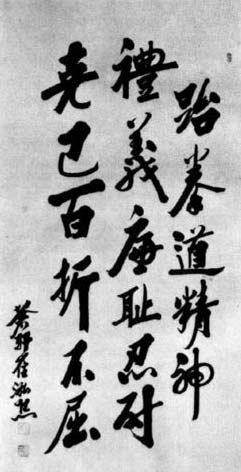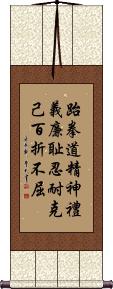Many custom options...
And formats...

Denial in Chinese / Japanese...
Buy a Denial calligraphy wall scroll here!
Personalize your custom “Denial” project by clicking the button next to your favorite “Denial” title below...
Self-Restraint / Self-Control
克己 can be translated as “self-denial,” “self-abnegation,” “self-restraint,” “self-discipline,” “self-mastery,” or selflessness.
As a tenet of Korean taekwondo, and other martial arts, this is often used with the title “self-control.”
Gaman
Gaman is a Zen Buddhist term from Japan that means “enduring the seemingly unbearable with patience and dignity.”
This title can also be translated as patience, perseverance, tolerance, or self-denial.
我慢 is also a Chinese Buddhist term with a different pronunciation. It comes from Sanskrit abhimāna or ātma-mada. Chinese Buddhism defines this very differently as “Egoism exalting self and depreciating others,” “self-intoxication,” or “pride.” Alone, the first character means “Me, I, or Self,” and the second character in a Buddhist context comes from Sanskrit māna and means pride, arrogance, self-conceit, looking down on others, superciliousness, etc.
I’m currently working with Japanese and Chinese translators to try and reconcile the true meaning or any commonality of this word between languages. For now, please only consider this if your audience is Japanese.
Taekwondo Tenets / Spirit of Taekwon-do
跆拳道精神禮義廉耻忍耐克己百折不屈 is General Choi's writing that is often called “The Tenets of Taekwon-do.”

The actual title would be translated as “Taekwondo Spirit” or “The Spirit of Taekwondo.” It was originally written in Korean Hanja (Chinese characters used in Korea for about 1600 years).
General Choi's original calligraphy is shown to the right. Your custom calligraphy will be unique, and not an exact match, as each calligrapher has their own style.In modern times, the common form of written Korean is Hangul (a phonetic character set). The table below shows the text in Hangul and Hanja along with a pronunciation guide and a brief English translation:
| Traditional Korean Hanja | Modern Korean Hangul | Pronunciation | English |
| 跆拳道精神 | 태권도정신 | tae gweon do jeong sin | Taekwondo Spirit |
| 禮儀 | 예의 | ye yi | Courtesy / Etiquette / Propriety / Decorum / Formality |
| 廉耻 | 염치 | yeom ci | Integrity / Sense of Honor |
| 忍耐 | 인내 | in nae | Patience / Perseverance / Endurance |
| 克己 | 극기 | geug gi | Self-Control / Self-Denial / Self-Abnegation |
| 百折不屈 | 백절불굴 | baeg jeor bur gur | Indomitable Spirit (Undaunted even after repeated attacks from the opponent) |
| Note that the pronunciation is the official version now used in South Korea. However, it is different than what you may be used to. For instance, “Taekwon-do” is “tae gweon do.” This new romanization is supposed to be closer to actual Korean pronunciation. | |||
Not the results for denial that you were looking for?
Below are some entries from our dictionary that may match your denial search...
| Characters If shown, 2nd row is Simp. Chinese |
Pronunciation Romanization |
Simple Dictionary Definition |
克己 see styles |
kè jǐ ke4 ji3 k`o chi ko chi kokki こっき |
More info & calligraphy: Self-Restraint / Self-Control(n,vs,vi) self-control; self-mastery; self-restraint; self-denial; (given name) Yoshimi |
五逆 see styles |
wǔ nì wu3 ni4 wu ni gogyaku ごぎゃく |
(1) {Buddh} five cardinal sins (killing one's father, killing one's mother, killing an arhat, shedding the blood of a Buddha, causing a schism within the sangha); (2) (hist) crime of killing one's master, father, grandfather, mother, or grandmother pañcānantarya; 五無間業 The five rebellious acts or deadly sins, parricide, matricide, killing an arhat, shedding the blood of a Buddha, destroying the harmony of the sangha, or fraternity. The above definition is common both to Hīnayāna and Mahāyāna. The lightest of these sins is the first; the heaviest the last. II. Another group is: (1) sacrilege, such as destroying temples, burning sutras, stealing a Buddha's or a monk's things, inducing others to do so, or taking pleasure therein; (2) slander, or abuse of the teaching of śrāvaka s, pratyekabuddhas, or bodhisattvas; (3) ill-treatment or killing of a monk; (4) any one of the five deadly sins given above; (5) denial of the karma consequences of ill deeds, acting or teaching others accordingly, and unceasing evil life. III. There are also five deadly sins, each of which is equal to each of the first set of five: (1) violation of a mother, or a fully ordained nun; (2) killing a bodhisattva in a sangha; (5) destroying a Buddha's stūpa. IV. The five unpardonable sin of Devadatta who (1) destroyed the harmony of the community; (2) injured Śākyamuni with a stone, shedding his blood; (3) induced the king to let loose a rutting elephant to trample down Śākyamuni; (4) killed a nun; (5) put poison on his finger-nails and saluted Śākyamuni intending to destroy him thereby. |
否定 see styles |
fǒu dìng fou3 ding4 fou ting hitei / hite ひてい |
to negate; to deny; to reject; negative (answer); negation (noun, transitive verb) (1) (ant: 肯定・1) denial; negation; repudiation; disavowal; (2) {logic} negation; (3) {comp} NOT operation |
否認 否认 see styles |
fǒu rèn fou3 ren4 fou jen hinin ひにん |
to declare to be untrue; to deny (noun, transitive verb) denial; negation; repudiation; disapproval |
打消 see styles |
dǎ xiāo da3 xiao1 ta hsiao uchikeshi うちけし |
to dispel (doubts, misgivings etc); to give up on (linguistics terminology) negation; denial; negative |
抹殺 抹杀 see styles |
mǒ shā mo3 sha1 mo sha massatsu まっさつ |
to erase; to cover traces; to obliterate evidence; to expunge; to blot out; to suppress (noun, transitive verb) (1) erasure; obliteration; (noun, transitive verb) (2) denial; ignoring (an opinion) |
拒否 see styles |
kyohi きょひ |
(noun, transitive verb) (ant: 承諾) refusal; rejection; denial; veto |
空寂 see styles |
kōng jì kong1 ji4 k`ung chi kung chi kuujaku / kujaku くうじゃく |
empty and silent; desolate (1) {Buddh} complete emptiness (i.e. as a denial of the inherent existence of all things); nirvana (where this emptiness is realized); (noun or adjectival noun) (2) (archaism) quiet and lonely Immaterial; a condition beyond disturbance, the condition of nirvana. |
認否 see styles |
ninpi にんぴ |
approval or disapproval; admission or denial |
非我 see styles |
fēi wǒ fei1 wo3 fei wo higa ひが |
{phil} (See 自我・1) non-ego; not-self denial of self-nature |
克己心 see styles |
kokkishin こっきしん |
spirit of self-denial |
全否定 see styles |
zenhitei / zenhite ぜんひてい |
(noun, transitive verb) complete denial; complete disavowal; total negation |
Variations: |
hata はた |
(adverb) (1) or; otherwise; (adverb) (2) furthermore; also; (adverb) (3) (archaism) perhaps; by some chance; possibly; (adverb) (4) (archaism) that being said; be that as it may; (adverb) (5) (archaism) however; but; (adverb) (6) (archaism) not to mention; needless to say; (adverb) (7) (archaism) as expected; sure enough; (adverb) (8) (archaism) (used to express emphatic denial, suspicion, or emotion) really; at all |
打消し see styles |
uchikeshi うちけし |
(linguistics terminology) negation; denial; negative |
ぴしゃり see styles |
pishari ぴしゃり |
(adv,adv-to) (onomatopoeic or mimetic word) slapping; splashing; splatting; banging shut; flat (refusal, denial, etc.) |
克己精進 see styles |
kokkishoujin / kokkishojin こっきしょうじん |
(noun/participle) self-control and close application; self-denial and diligent devotion |
全面否定 see styles |
zenmenhitei / zenmenhite ぜんめんひてい |
(noun/participle) total denial; complete denial; denying totally (flatly, outright) |
因果應報 因果应报 see styles |
yīn guǒ yìng bào yin1 guo3 ying4 bao4 yin kuo ying pao inga ōhō |
Cause and effect in the moral realm have their corresponding relations, the denial of which destroys all moral responsibility. |
打ち消し see styles |
uchikeshi うちけし |
(linguistics terminology) negation; denial; negative |
拒否処分 see styles |
kyohishobun きょひしょぶん |
(judicial) denial |
現状否定 see styles |
genjouhitei / genjohite げんじょうひてい |
refusal to accept the present situation; denial of the existing situation; negation of the status quo |
自己否定 see styles |
jikohitei / jikohite じこひてい |
(noun/participle) self-denial |
頭を振る see styles |
kaburiofuru かぶりをふる |
(exp,v5r) to shake one's head (in denial) |
DoS攻撃 see styles |
dosukougeki; diiooesukougeki / dosukogeki; diooesukogeki ドスこうげき; ディーオーエスこうげき |
{internet} denial-of-service attack; DoS attack |
かぶりを振る see styles |
kaburiofuru かぶりをふる |
(exp,v5r) to shake one's head (in denial) |
サービスの妨害 see styles |
saabisunobougai / sabisunobogai サービスのぼうがい |
{comp} denial of service |
分佈式拒絕服務 分布式拒绝服务 see styles |
fēn bù shì jù jué fú wù fen1 bu4 shi4 ju4 jue2 fu2 wu4 fen pu shih chü chüeh fu wu |
distributed denial of service (DDOS) form of Internet attack |
分散DoS攻撃 see styles |
bunsandiiooesukougeki / bunsandiooesukogeki ぶんさんディーオーエスこうげき |
{comp} Distributed Denial of Service attacks |
サービス不能攻撃 see styles |
saabisufunoukougeki / sabisufunokogeki サービスふのうこうげき |
{comp} denial of service attack |
サービス妨害攻撃 see styles |
saabisubougaikougeki / sabisubogaikogeki サービスぼうがいこうげき |
{comp} denial of service attack |
Click here for more denial results from our dictionary
The following table may be helpful for those studying Chinese or Japanese...
| Title | Characters | Romaji (Romanized Japanese) | Various forms of Romanized Chinese | |
| Self-Restraint Self-Control | 克己 / 剋己 克己 | kokki / koki | kè jǐ / ke4 ji3 / ke ji / keji | k`o chi / kochi / ko chi |
| Gaman | 我慢 | ga man / gaman | wǒ màn / wo3 man4 / wo man / woman | |
| Taekwondo Tenets Spirit of Taekwon-do | 跆拳道精神禮義廉耻忍耐克己百折不屈 跆拳道精神礼义廉耻忍耐克己百折不屈 | tái quán dào jīng shén lǐ yì lián chǐ rěn nài kè jǐ bǎi zhé bù qū tai2 quan2 dao4 jing1 shen2 li3 yi4 lian2 chi3 ren3 nai4 ke4 ji3 bai3 zhe2 bu4 qu1 tai quan dao jing shen li yi lian chi ren nai ke ji bai zhe bu qu | t`ai ch`üan tao ching shen li i lien ch`ih jen nai k`o chi pai che pu ch`ü tai chüan tao ching shen li i lien chih jen nai ko chi pai che pu chü |
|
| In some entries above you will see that characters have different versions above and below a line. In these cases, the characters above the line are Traditional Chinese, while the ones below are Simplified Chinese. | ||||
Successful Chinese Character and Japanese Kanji calligraphy searches within the last few hours...






